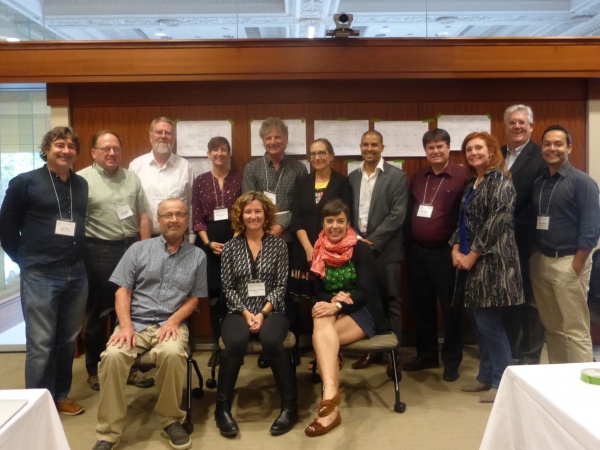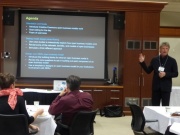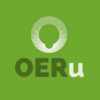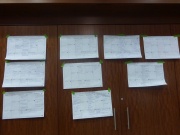North American OERu 15.09 regional meeting

Summary
Representatives from Athabasca University, Creative Commons,OER Foundation, BCcampus, Portage College, Kwantlen Polytechnic University, go2HR and Thompson Rivers University convened in Vancouver for the inaugural OERu North American Regional meeting on September 17, 2015.
The purpose of the meeting was to design, discuss and develop open business models from the perspective of OERu partner institutions, and in particular build on the ideas developed at the Oceania meeting. The outputs from this meeting and the Oceania Regional meeting will be tabled at the OERu 2015 Partner's and Chief Executive Officers meetings in October 2015 in South Africa.
Paul Stacey, Associate Director of Global Learning at Creative Commons was the lead facilitator for the meeting. Paul is actively involved in leading a global initiative exploring open business models based on works licensed under Creative Commons.
Pre-meeting activities
Participants were invited to contribute to the following pre-meeting activities in preparation for the meeting:
- Complete the OERu input evaluation survey.
- Consult the OERu Strategic Plan 2015 - 2017.
- Review the first draft of an OERu open business model developed from the perspective of the OER Foundation.
- Contribute to open business model conversations on community.oeru.org.
Orientation
Meeting host Mary Burgess, Executive Director of BCcampus opened the meeting with a welcome to all.
Irwin DeVries gave recent members and participants a brief overview of the OERu goals and logic model, and provided an update of the preparations under way for the upcoming OERu October Annual Members Meeting in South Africa. He described the work of the Management Committee and also invited participants who are not currently members of any of the OERu working groups.
Jim Tittsler highlighted two new open source communication technologies used to support the planning and implementation of the OERu:
- groups.oeru.org which functions as an open email list with a public record of the working group conversations. This is an opt-in system. Users can self-register or the conveners of working groups will email invitations to join the respective list.
- community.oeru.org site which will become the main communication hub of the OERu community. This is an early pre-launch version of the site and participants were invited to assist with populating the community.oeru.org with authentic questions in preparation of the main launch of the technology.
The notes for the following three sections have been adopted from the Oceania meeting as the same presentation by Paul Stacey was made at both meetings.
Designing and developing open business models for the OERu
Paul Stacey affirmed the aims of the meeting, namely to design and develop open business models from the perspective of the individual OERu partner institutions noting alignment with the OERu's Strategic Goal 3: "Achieve a fiscally sustainable and scalable OERu network". The outputs of the regional open business model meetings will be tabled at the annual meeting of OERu partners and Council of CEO's meeting in October 2015 in South Africa. Paul started with an exercise to "park" some of the fears of "open", encouraging participants to share their own concerns or those that colleagues had expressed.
Getting open business model design juices flowing

Paul commenced the session by comparing the closed and open innovation paradigms drawing on the work of Chesborough (2006)[1]. Paul referenced the successes of the open source software movement highlighting different business approaches from Raymond's (1999) seminal publication documenting the GNU/Linux development model: The Cathedral and the Bazaar[2]. The group was invited to explore and share thoughts on a number of open business models:
- Why give away your work for free? - looking at how the novelist, Cory Doctorow publishes novels for free online while sustaining sales.
- Nina Paley's film, Sita Sings the Blues which can be downloaded for free under a CC-BY-SA license.
- The revenue model of the Rijksmuseum providing free access to digitised versions of the museums art collection.
- Examining the Commons with particular reference to a number of publications on the Commons (see Slide 18).
- Discussion of Flickr's controversial "Wall Art program", where revenue generated from selected CC-BY licensed images hosted on Flickr and printed for resale did not include revenue sharing with the copyright holders, when compared to the revenue sharing model used in the case of all rights reserved images.
Developing individual business models
The approach used for the meeting is derived from the book, Business Model Generation (Osterwalder & Pigneur 2009)[3], co-created by 470 practitioners from 45 different countries. The canvas concept is designed to explain a "business on a page". See for example this Open business model canvas template.
Paul summarised the canvas and tasked participants to individually develop an open business model using the handout sheets for their respective institutions. Following is an aggregated summary of the points added to the sheets, in the four areas of focus in the session.
Customer segments
- Everyone - everywhere
- Guests - learners engaging out of curiosity
- Customers - learners engaging to obtain a credential
- Researchers
- Local students
- Provincial/International credit for interest
- Learners with barriers to education
- Paying/not paying
- Faculty, as PD or for course development/redevelopment
- Not-for-Profits
- Industry partners
- Aboriginal/first peoples
- CE students
- Professional organizations
- Government, entire educational systems
- Future immigrants
- HE partner institutions
- Community volunteers
- Developing countries
- Employees and employers
- New immigrants
- New entrants to the job market
Value Proposition
- Current, relevant, accessible, affordable globally respected course and programs, recognized for transfer to all partner institutions
- Engaging
- Foundational and entry level programs
- Interaction among different students from different locations globally
- Pathways to new careers
- Access to innovation, research
- Sharing best practices
- Resource for instructions in course development
- Model of good pedagogy and instructional design
- Good PR for participating institutions
- Faculty recognition (course lives on)
- Open textbooks
- Many courses for the price of one (for institutional use)
- Promote open educational practices at our institutions
- Open textbooks that can accompany open courses
- Advocate for open licensing
- Skill acquisition
- Cost savings
- Sense of belonging to a community
- Microcredentialing and badging
Social Good
- Creating a norm of openness and sharing
- Challenging tradition
- All people have potential and deserve an opportunity to access quality higher education
- Free learning opportunity, skill development and credentialing
- Sharing projects with different parts of the world
- Community education and credentialing
- Meets university service role
- Free open educational resources
- More efficient use of government funds due to collaboration
- Labour market demand met
- Community development
Revenue Streams
- PLAR
- Proctoring/marking fees
- Campus fees paying
- Credentialing
- On campus students paying to take additional OERu courses
- FTE calculations to increase funding
- Professional organizations
- Continental help desk
- Consulting fees
- Fees for events/workshops
- Training/retention tools
- Grants and partnerships
Discussion
The group was then debriefed on their individual work on their canvases. The discussion of customer segments ranged from wide open - i.e.anyone who would find value in participating in the OERu - to a very specific focus on students wanting to complete credentials via OERu courses and partner institution credit. With reference to the 2015 Oceania partner meeting canvas, individuals worked on their own institutional canvases and then debriefed the main contents. Two main findings:
- It was agreed that the potential of the OERu is vast and there are many opinions as to the main focus of the partnership.
- Further North American partner meetings should occur over time
BCcampus and Paul Stacey were thanked for hosting and facilitating a very productive meeting.
References
- ↑ Chesborough, H.W. 2006. Open Innovation: The New Imperative for Creating and Profiting from Technology. Harvard University Press
- ↑ Raymond, Eric S. (1999). The Cathedral and the Bazaar: Musings on Linux and Open Source by an Accidental Revolutionary.
- ↑ Osterwalder, A and Pigneur, Y. (2009) Business Model Generation. Strategyzer.

